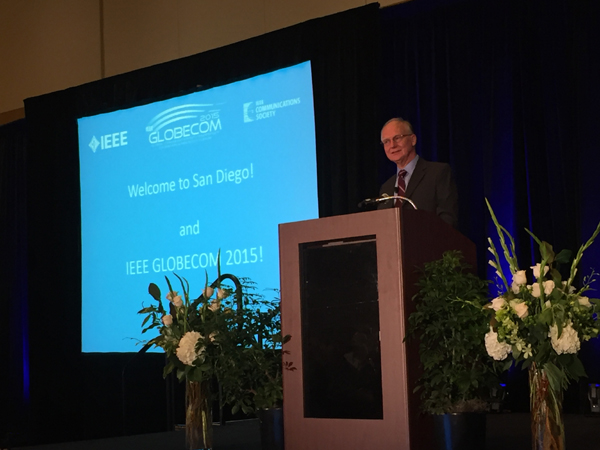This was my first time attending IEEE GLOBECOM that is one of two flagship conferences of the IEEE Communications Society (the other one is IEEE ICC). It drew more than 2300 scientists, researchers and industry experts this year and focused on the hot topics of 5G and IoT. The technical program included oral or poster presentations including about 850 scientific papers, grouped into 12 thematic symposia with more than 15 parallel sessions. In addition to the technical program, IEEE GLOBECOM 2015 featured an industry forum and exhibition program, including industry-focused workshops, tutorials, keynote talks from industrial leaders, panel discussions, small exposition, and business and industrial forums. I was really impressed with the quality of the attendees from CTOs to engineers to university professors.
I spent most of my time in the industry panel sessions discussing 5G research activities and debating the various approaches for future communication systems. Leading companies like Qualcomm, Intel, Huawei, ViaSat, Keysight and National Instruments to name a few were key contributors and were represented with larger booths in the exhibition area. The Keysight booth was packed with demo areas featuring 5G waveform generation and analysis, 5G channel sounding, 5G system-level design and verification, and IoT device testing. The sub-6 GHz coexistence between 5G and 4G Waveforms Test Solutions was interesting as engineers can pick from a library of various waveforms plus input your own and visually see how they will interact with each other. This can also include radar, LTE, WiFi and white space signals which can also enter into the complicated signals environment we live in today. National Instruments also had a plethora of demos including Massive MIMO real-time prototyping, real-time beam steering for mmWave applications, deploying C-RAN and sub-Nyquist sampling for SDR, UWB and radar (in association with Technion). The live mmWave beam steering demonstration using SiBeam hardware was interesting to see the ability to integrate with third party components in addition to NI hardware. The sub-Nyquist cognitive radio demo developed by the Signal Acquisition and Modeling Lab at Technion Israel Institute of Technology was impressive as it samples up to 3 GHz of bandwidth at an effective rate of 360 MHz, just 6% of the Nyquist limit.

The keynotes on the first day were given by Mark Dankberg, Co-founder and CEO of ViaSat, and Eric Starkloff, EVP of Global Sales and Marketing at NI. I was surprised at how effective satellite coverage is as he showed that satellite providers have a better ROI than other terrestrial providers. He stated that 3 GEO satellites can cover the whole planet with not much loss in effective power flux over the area. Eric discussed the dominance of IoT by IIoT (Industrial Internet of Things) being the project as the bulk of connected devices to the Internet in the future. He outlined 4 key areas of development: Massive MIMO, Wireless Networks, Multi-RAT and mmWave systems and covered some recent 5G mmWave demonstrations from Nokia and Samsung.
The keynotes for the second day were Matt Grob, EVP and CTO at Qualcomm, and Jay Alexander, CTO at Keysight. Matt discussed how the first 5G release in 2020 is expected to be sub 6 GHz along with 4G LTE/LTE-A continuing to support most subscribers. Then in a year of two after that, we might have full mmWave, stand alone 5G networks. He cited many 60 GHz systems being used now like VIVE 802.11ad from Qualcomm, Intel’s 60 GHz system being demonstrated live in their booth and SiBeam’s 60 GHz system which was in the NI booth as precursors for future systems. Jay covered Keysight’s evolution from HP to Agilent and now Keysight as a standalone company. They are merging their software and hardware platforms to provide customers with out-of-the box solutions to speed their development.
Other key talks that I was not able to catch were Seizo Onoe, EVP and CTO of NTT DOCOMO, covering the evolution toward 5G and beyond; Wen Tong, CTO at Huawei, discussing bringing 5G into reality; and Sachin Katti, Assistant professor at Stanford University, talking about full duplex radio systems. The reality of full-duplex radios would be significant.
Although many want to believe that 5G will be implemented with very low latency, high speed mmWave connections in 2020, many panelists think it will be a gradual implementation that starts with more conventional frequencies and progresses to other modulation protocols and higher frequencies that lead to this end goal a couple of years later. 5G may have to overlay onto the current 4G systems as billions will be invested over the next 5 years so coexistence is a big issue. There is also the complication of billions of IoT devices that have opposing needs of high speed, low latency connections as many IoT devices will only need low data rates but will require very low power networks. We still have a lot of research to do in the area of 5G to work out these issues. So it will be very exciting over the next few years to see how this plays out.
Video demos from Globecom 2015
Picture gallery from Globecom 2015

